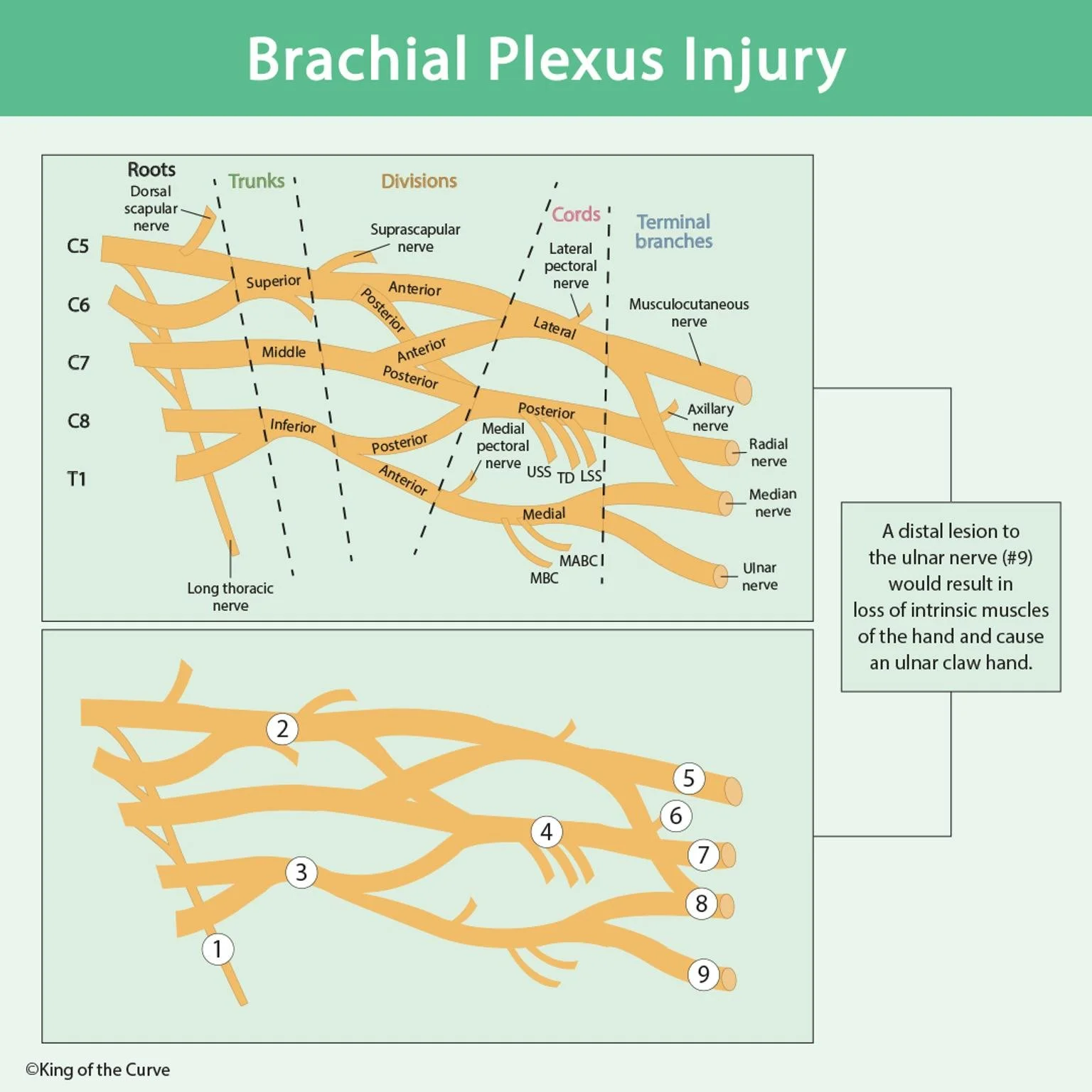🧠 Understanding Brachial Plexus Injury: Nerve Anatomy and Clinical Relevance
The brachial plexus is a critical nerve network that originates from the spinal roots of C5 through T1, forming an intricate structure responsible for motor and sensory innervation of the upper limb. Injury to any part of this network can lead to significant functional impairments, depending on the location and severity of the lesion.
🔍 Anatomy of the Brachial Plexus
The brachial plexus is traditionally divided into five major components:
Roots (C5-T1)
Trunks (Superior, Middle, Inferior)
Divisions (Anterior and Posterior)
Cords (Lateral, Posterior, Medial)
Terminal Branches (Musculocutaneous, Axillary, Radial, Median, and Ulnar)
Each of these structures contributes to specific regions of the upper limb, and disruption at any point can lead to characteristic symptoms.
💥 Brachial Plexus Injuries: Causes and Consequences
Injury to the brachial plexus can occur due to:
Birth trauma (e.g., Erb's or Klumpke’s palsy)
Blunt trauma (e.g., motor vehicle accidents)
Penetrating injuries
Repetitive stress or overuse
✋ Ulnar Nerve (#9) Injury – The Ulnar Claw
The ulnar nerve arises from the medial cord and primarily innervates the intrinsic muscles of the hand and part of the forearm flexors.
Distal lesions (e.g., at the wrist) lead to a classic "ulnar claw" deformity due to unopposed action of the extensor muscles.
There is also loss of fine motor skills, decreased grip strength, and sensory loss in the 4th and 5th digits.
This injury is highlighted in the diagram, showing the path and location of the ulnar nerve (marked #9).
📚 Clinical Tips: Localizing the Lesion
Understanding the anatomy helps localize lesions:
Proximal lesions (e.g., at roots or trunks) affect multiple muscles and nerves.
Distal lesions (e.g., terminal branches) produce more localized deficits.
Example:
Radial nerve injury results in wrist drop.
Median nerve injury causes ape hand or hand of benediction.
Musculocutaneous nerve damage reduces elbow flexion.
🧬 Why This Matters
Proper identification of the lesion site aids in:
Diagnosis
Targeted treatment (e.g., nerve grafting, physical therapy)
Prognostic evaluation
A comprehensive understanding of this network is crucial for neurologists, orthopedic surgeons, and physical therapists.
🔎 Summary
The brachial plexus is a master network connecting the spine to the arm. Whether you're diagnosing nerve damage or preparing for a clinical exam, understanding this roadmap and its possible injuries—like ulnar nerve lesions—offers a foundational advantage.
Pro Tip: Memorize the layout by using mnemonics like "Randy Travis Drinks Cold Beer" (Roots, Trunks, Divisions, Cords, Branches).
Frequently Asked Questions (FAQs)
-
Aim for 4-6 focused hours, ensuring you incorporate breaks to avoid burnout.
-
Practice mindfulness techniques, take practice exams under realistic conditions, and maintain a balanced lifestyle.
-
Set short-term goals, seek support from mentors, and reward yourself for small achievements.
-
Regular exercise improves focus, reduces stress, and enhances overall mental clarity.
-
KOTC offers personalized learning tools, gamification features, and adaptive question banks to help students stay on track without burnout.


